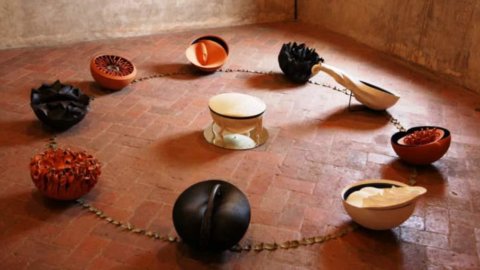On the occasion of the sixth edition of ConCreta, which will be held from 29 June to 3 September, the exhibition spaces of Casa Boccaccio in Certaldo will host the sculptural work of Enrico Stropparo "Prooemium". It is a composition of ten "bowls" which synthetically represent the psychological characteristics of the ten narrative characters of Giovanni Boccaccio's Decameron: Elissa the adolescent, Panfilo the lucky lover, Filostrato the unhappy troubled one, Pampinea the opulent, Dioneo the lascivious, Fiammetta rejoicing in love, Neifile the gay and sensual, Lauretta the jealous, Filomena the ardent and Emilia intent on herself. The technique is complex but refined, in fact each container was made in polychrome terracotta, slips and oxides.
The composition was presented for the first time during the first edition of ConCreta, an international ceramic sculpture exhibition, at Palazzo Pretorio in 2007. “The bowl, as we know, is the alpha and the omega for the ceramic artist, the point of every beginning and every landing place, the source shape and the universe of the possible. It is, conventionally setting aside any practical implications, a sort of very idea of form. Curve of beloved body and geometry, matter that smells of the organic and spring knowledge of the hand, the bowl is understood by Stropparo as the vrai lieu (just to evoke another poet, Yves Bonnefoy) of all his visionary passages. He reflects on it of his own primary formal configuration, he makes it inhabit by his humorous reveries in which play and constructive experiment take place, the will to design and the pure inspiration of invention. And then he arranges them, in paths which in turn become a modifying presence, an articulation of space”.
Enrico Stropparo
Born in Tezze sul Brenta in 1953, he was a pupil of Alessio Tasca in Nove and in Venice of Alberto Viani.
After the experiments on "cotto" influenced by Tasca, he begins an original work on clays and refractories mixed with oxides and worked "with inlay". The only colors are those of the same lands used. Almost investigating the limits of the ceramic technique, Stropparo modulates geometries and quotations on the slabs, in a modern key, of the historical characteristics of Venetian architecture. The decorative contribution of the architectural details of the ancient Venetian tradition – sensitive, by environmental vocation, to the slightest variation of light – translates into works that will be developed in the subsequent series, from the 1989s, of unique pieces with a strong architectural character. Technical preciousness and allusive charge earned him the Faenza Prize in XNUMX. After a meditative period of creative stasis, Stropparo returned to work and the bowls on display, dedicated to characters from the Decameron and, therefore, also to Certaldo, are among the first examples of the hoped-for "rebirth" of an artist who has been able to combine severe technical research with declared concessions to desecrating and playful artistic tendencies."





